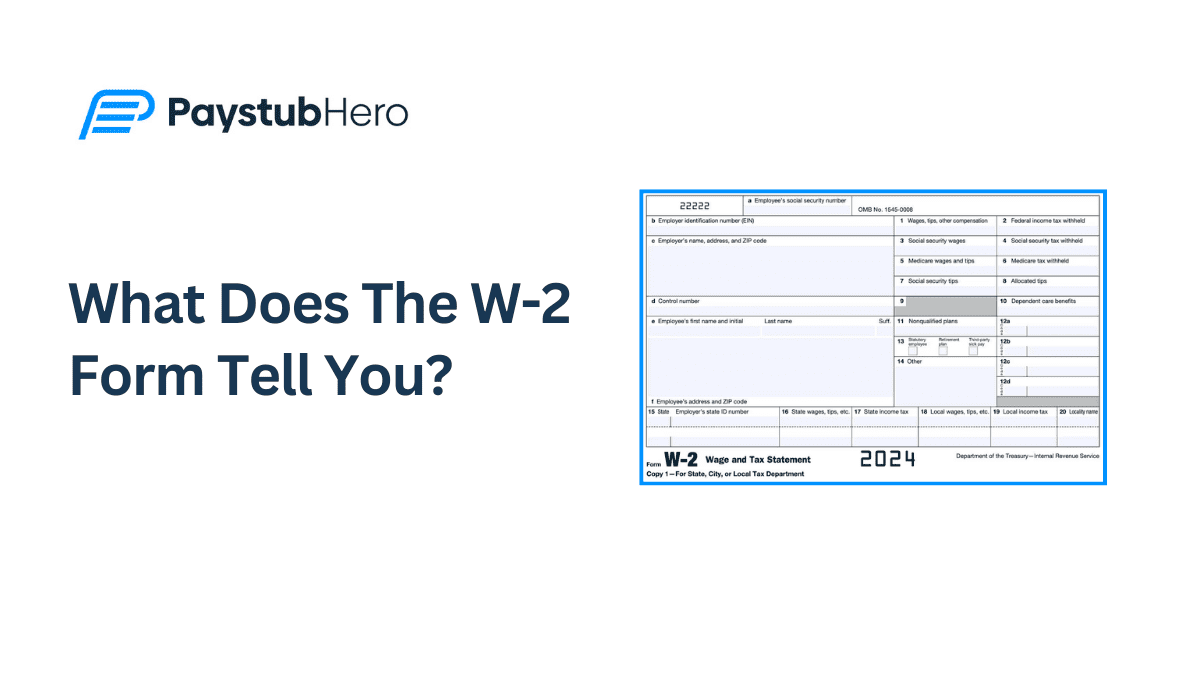The W-2 form is basically a summary of what you earned and the taxes you paid last year. Let’s break it down section by section.
What Does a W-2 Tell You?
The W-2 form is organized into sections to help make sense of all the details. The first section, employee’s earnings and taxes, focuses on your income and the taxes that were taken out.
1. Employee’s Earnings and Taxes
Here’s what this part will tell you:
➡ Wages, Tips, and Other Compensation
This is the first section on your W-2, and it’s arguably the most important. It shows the total amount of taxable income you earned from your employer over the past year.
This number includes:
⦿ Regular Wages: Your hourly or salaried pay.
⦿ Overtime: Any extra hours worked at a higher pay rate.
⦿ Bonuses: Additional payments like end-of-year bonuses.
⦿ Tips: If you’re in a job where tips are part of your income, they’re included here.
Why It’s Important
This figure determines the income tax you owe to the federal and state governments. It’s the foundation for your tax return.
Example
Let’s say you worked as a full-time employee and earned:
⦿ $50,000 in regular wages.
⦿ $5,000 in overtime.
⦿ A $1,000 holiday bonus.
If you received no tips, your total compensation in Section 1 would show $56,000.
Things to Note
⦿ If this amount seems off, double-check your pay stubs for the year to ensure all earnings were reported correctly.
⦿ Non-taxable benefits, like contributions to certain retirement accounts, won’t appear here.
Up next, we’ll tackle Section 2: Federal Income Tax Withheld, which explains how much tax you’ve already paid.
➡ Federal Income Tax Withheld
Now that we know how much you earned, let’s look at how much of it went to the federal government. This section shows the total amount of federal income tax your employer withheld from your paycheck throughout the year.
Why It Matters
This amount represents your tax contributions so far. When you file your tax return, it’s compared to what you actually owe.
If you paid more than necessary, you’ll get a refund. If not, you might owe more.
How It’s Calculated
The amount withheld depends on the details you provided on your W-4 form, such as:
⦿ Your filing status (single, married, etc.).
⦿ The number of allowances or dependents you claimed.
⦿ Any additional amount you requested to be withheld.
Example
Let’s say your annual salary was $56,000, and your employer withheld $6,500 for federal income tax over the year.
That $6,500 is what you’ll see in Section 2.
What to Check
⦿ Does the number seem reasonable based on your income?
⦿ If it looks off, it’s worth reviewing your pay stubs and W-4 form.
Next, we’ll dive into Section 3: Social Security Tax Withheld, which is all about contributions to your future.
➡ Social Security Tax Withheld
This part shows how much of your pay was set aside for Social Security.
The funds help provide financial support for retirement, disabilities, or family benefits after a loved one passes.
Why It’s Important
This contribution is your share toward the Social Security system. It’s deducted automatically, so you don’t need to do anything to contribute.
How It Works
The tax rate is a fixed percentage applied to your earnings, but only up to a certain limit (called the wage base limit).
For example, in 2023, the rate was 6.2%, with a maximum taxable income of $160,200.
Example
If you made $56,000, your Social Security tax would be:
$56,000 × 6.2% = $3,472. That’s the amount recorded in this section.
Things to Check
⦿ If you worked multiple jobs, make sure the total withheld doesn’t exceed the limit.
⦿ Keep an eye on this number to ensure it matches what was deducted from your pay.
Next, we’ll break down the medicare tax withheld, which goes toward another critical health program.
➡ Medicare Tax Withheld
This section shows how much money was taken out of your pay for Medicare. Medicare is a program that helps cover health care costs for people 65 and older or those with certain disabilities.
Why It Matters
The tax rate for Medicare is 1.45% of your total earnings. If you earn over a certain amount (like $200,000 if you’re single), you’ll also pay an extra 0.9% on the amount above that limit.
How It’s Calculated
If you made $56,000 last year, your Medicare tax would be:
$56,000 × 1.45% = $812.
That’s the amount you’ll see here.
What to Check
⦿ Does the amount match your income?
⦿ If you earned more than $200,000, was the extra tax applied?
2. Tax Adjustments and State/Local Tax Information
The second part of a W-2 above focuses on benefits, adjustments, and taxes tied to your specific situation.
This section includes details like dependent care benefits, nonqualified plans, state wages, and local taxes. It’s where you’ll see how your earnings and taxes are adjusted based on things like retirement contributions or state-specific rules.
These categories give a more personalized breakdown of your taxes and benefits, ensuring everything is accounted for properly.
3. Additional Tax Information
Now let’s look at the third part of a W-2, additional tax information.
This section includes extra details about your income and benefits that don’t fit into the main earnings and taxes category. While it may not apply to everyone, it’s worth understanding what’s listed here.
Box 12 is all about codes.
These codes represent specific benefits or payments. For instance, if you contributed to a 401(k) retirement plan, you’d see the amount recorded with a code like “D.”
Similarly, if your employer provided health insurance or other benefits, those amounts would also show up here. These codes highlight how much was allocated for things like your retirement or health care.
Then there’s Box 13, which checks for special situations.
Have you ever been labeled a statutory employee? This means you’re treated like a self-employed person for tax purposes, even though you get a W-2. If this applies to you, the box will be checked, ensuring your taxes are handled properly.
Finally, we have Box 14. This one is a bit of a catch-all.
Employers use it to report anything else they think is important, like union dues, tuition assistance, or even reimbursements for uniforms. It’s a flexible space to note any extra details about your income.
Need Help Creating W-2s or Other Important Tax Documents?
Understanding your W-2 is important, but creating one doesn’t have to be stressful.
PaystubHero’s generators make it easy, whether you’re a small business managing payroll, a contractor tracking finances, or someone needing proof of income. With tools like W-2 and paystub generators, we help you save time, stay accurate, and keep everything compliant.
FAQs
Most frequently asked about W2s are:
Yes, you need to report all W-2 forms you receive when filing your taxes. Each W-2 represents income you earned from a different employer. Failing to report even one W-2 can lead to discrepancies and potential issues with the IRS.
If you find an error on your W-2, such as an incorrect Social Security number, name, or earnings amount, contact your employer's payroll or human resources department immediately. They are responsible for issuing corrected W-2s (Form W-2c).
Do not attempt to correct the W-2 yourself.




